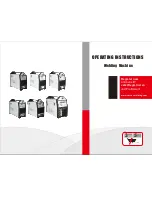
EN-3
•
Prior to any welding or cutting operation, cle-
ar the working area from all chlorine solvents,
which are normally used to clean or degrea-
se the working material. The fumes of these
solvents, when submitted to the radiations of
an electric arc, even from afar, may, in some
cases, transform into toxic gases. Make sure
all the pieces which are to be welded or cut
are absolutely dry.
Warning: When the welding operator is in
a closed space, the use of chlorine solvents
is absolutely forbidden in the presence of
electric arcs.
•
During the grinding, brushing and hamme-
ring operations involving the welded pieces,
always wear protection goggles with transpa-
rent lens to prevent projected chips and any
other foreign particles from hurting your eyes
(Fig. 5).
and, if necessary, masks with suitable protection
filter (Fig. 4).
Figure 4
Figure 6
Figure 5
Unhealthy or dangerous gases or fumes must be
collected (as they are produced) as close and effi-
ciently as possible to the source of emission, in such
a manner that the concentration of pollutants does
not exceed the permitted limits (Fig. 6). In addition,
all welding operations must be carried out on metal
surfaces devoid of rust and paint, to avoid the
formation of hazardous fumes.
Any symptom of discomfort or pain in the eyes, nose
or throat may be caused by inadequate ventilation;
if this is the case, immediately interrupt work and
ventilate the area.
Do not weld or cut metals or painted metals contai-
ning zinc, lead, cadmium or beryllium, unless the
operator and the persons nearby are using breathing
apparatuses or wearing helmets with oxygen cylinder.
Should welding or cutting operations be carried out
in conditions different from the usual working condi-
tions, with an increased risk of electric shock (reduced
or damp working area), additional precautions must
be taken, such as:
•
Using power generators marked “S”;
•
Placing the power generator out of the wor-
king area;
•
Reinforcing personal protection devices,
ground insulation and insulation between the
piece to be welded and the operator (Fig. 7).
Figure 7
Workers and their assistances must never allow
any parts of their bodies to come into contact with
metallic materials at high temperatures or which are
moving (Fig. 8).
Summary of Contents for PC EVO 126
Page 36: ...77612041...






































